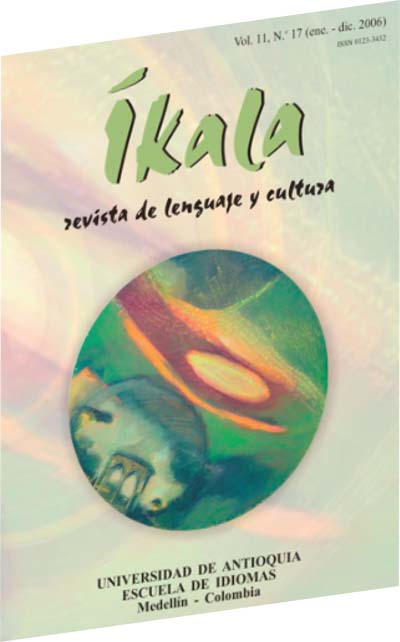*Developing a Coherent System for the Assessment of Writing Abilities: Tasks and Tools
DOI :
https://doi.org/10.17533/udea.ikala.2791Mots-clés :
standards d'écriture, validité du construct, tâches évaluatives de l'écrit, fiabilité interne, rubriquesRésumé
Cet article présente le développement et la validation d'un système d'évaluation de l'écrit. L'on présente deux processus essentiels qui sont la validation du construct linguistique et des tâches évaluatives puis l'élaboration et la validation des instruments évaluatifs. La validation du construct a été déterminée à travers sa définition et son alignement avec les standards d'écriture par niveau de suffisance, et avec les tâches évaluatives. Afin de valider ces dernières, nous avons analysé leur contenu en répondant à des critères pour le développement des activités évaluatives appropriées et en demandant aux étudiants leur compréhension des instructions écrites. Nous avons élaboré des grilles d'évaluation et leur validité a été définie selon leur alignement avec les standards, le construct et l'estimation de fiabilité interne chez les évaluateurs (r > = 0.7).
Reçu: 09-03-06 / Accepté: 19-07-06
Comment Citer cet article:
Muñoz, A. P.; Mueller, J.; Álvarez, M. E. & Gaviria, S. (2006). Developing a Coherent System for the Assessment of Writing Abilities: Tasks and Tools. Íkala. 11(1), pp. 265 – 307
Téléchargements
Références
Alderson, J. C. & D. Wall, 2001, Language test construction and evaluation, Cambridge, Cambridge University Press.
Bachman, L. & A. Palmer, 1996, Language testing in practice: Designing and developing useful tests, Oxford, Oxford University Press.
Bachman, L., 1990, Fundamental considerations in language testing, Oxford, Oxford University Press.
Bailey, K. 1996, “Working for washback: a review of the washback concept in language testing”, Language Testing 13, 257–79.
Bereiter, C. and M. Scardamalia, 1987, The psychology of written composition, Hillsdale, NJ, Lawrence Erlbaum Associates.
Berkowitz, D. et al., 2000, The use of texts as part of High-Stakes decision-making for students: A Resource Guide for educators and policy-makers, Washington, DC, U.S. Department of Education.
Canale, M. and M. Swain, 1980, “Theoretical bases of communicative approaches to second language teaching and testing”, Applied Linguistics 1, (1), 1- 47.
Carr, J. F., & D. E. Harris, 2001, Succeeding with standards: Linking curriculum, assessment, and action planning, Alexandria, VA, ASCD.
Council of Europe, 2001, Common European framework of reference for languages: Learning, teaching, assessment, Cambridge, Cambridge University Press.
Douglas, D., 2000, Assessing language for specific purposes, Cambridge, Cambridge University Press. 294 Íkala, revista de lenguaje y cultura Vol. 11, N.º 17 (ene.-dic., 2006)
Grabe, W. and Kaplan, R. B., 1989, “Writing in a second language: Contrastive rhetoric”. In D. M. Johnson and D. H. Roen (eds.), Richness in writing. New York and London: Longman.
Green, S., 2002, Criterion referenced assessment as a guide to learning – The importance of progression and reliability. A paper presented at the association for the study of evaluation in education. Southern Africa International Conference.
Guskey, T. R., 2001, “Helping standards make the grade”, Educational Leadership, 59, 20-27.
Hale, G., et al., 1996, A study of writing tasks assigned in academic degree programs, TOEFL Research report No. 54, Princeton, NJ, Educational Testing Service.
Hughes, A. 1989, Testing for language teachers, New York: Cambridge University Press.
Hyland, K., 2003, Second language writing, Cambridge: Cambridge University Press.
Hymes, D. 1972, “On communicative competence”, in J. Pride and H. Holmes (eds.), Sociolinguistics, NY, Penguin, 269 – 93.
Marzano, R. J., et al., 2001, Classroom instruction that works: Research-based strategies for increasing student achievement, Alexandria, VA, ASCD.
Messick, S. 1996, “Validity and washback in language testing”, Language Testing 13(3), 241-256.
Messick, S., 1989, “Meaning and values in test validation: the science and ethics of assessment”, Educational Researcher 18 (2), 5-11.
Mueller, J., 2004, Authentic Assessment Toolbox, [Retrieved: March, 2005] Natriello, G., & S.
M. Dornbusch, 1984, Teacher evaluative standards and student effort, New York, Longman.
Purves et al., 1984, “Towards a domain-referenced system for classifying assignments”, Research in the Teaching of English. 18 (4), 385 – 416.
Rea-Dickins, P. & K. Germaine, 1992, Evaluation, Oxford: Oxford University Press. Reid, J. and B. Kroll, 1995, “Designing and assessing effective classroom writing assignments for NES and ESL students”, Journal of second language writing 4 (1), 17-41.
Stansfield, C., J. & Ross, 1988, “A long-term research agenda for the Test of Written English”, Language Testing, 5, 160-186.
Troman, G. 1989, “Testing tension: The politics of educational assessment”, British Educational Research Journal, 15, 279-295
Weigle, Sara, 2002, Assessing Writing, Cambridge, Cambridge University Press.
Weigle, S., 1994, “Effects of training on raters of ESL compositions”, Language Testing, 11, 197-223.
Weir, C. J., 1990, Communicative language testing, London, Prentice Hall. Widdowson, H., 1979, Explorations in applied linguistics, Oxford, Oxford University Press.
Wiggins, G., 1998, Educative assessment: Designing assessments to inform and improve student performance, San Francisco, CA, Jossey-Bass Publishers.
Téléchargements
Publié-e
Comment citer
Numéro
Rubrique
Licence
(c) Tous droits réservés Íkala, Revista de Lenguaje y Cultura 2006

Cette œuvre est sous licence Creative Commons Attribution - Pas d'Utilisation Commerciale - Partage dans les Mêmes Conditions 4.0 International.












